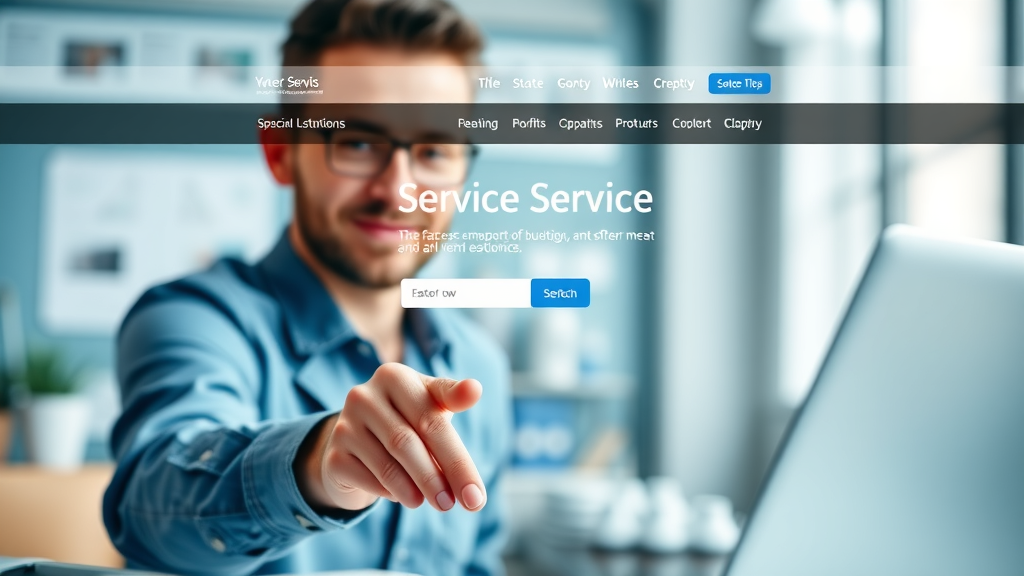Did you know that over 75% of potential clients search for professional services online before making a hiring decision? The landscape of client acquisition has shifted dramatically. Service providers who neglect online marketing are now missing out on the fastest, most scalable way to grow their business. In this guide, you’ll discover the powerful digital marketing strategies and actionable steps that can turn your online presence into a consistent engine for winning new clients—and staying ahead in your field.
Why Online Marketing for Service Providers Is Transforming How Clients Are Won
Today’s service businesses face fierce competition due to consumers’ digital-first habits. The most successful professional services are those who recognize that the majority of their potential customers are searching online for solutions before reaching out to an expert. Recent data highlights that over three out of four clients research online prior to hiring, shifting the power from traditional marketing methods like print ads and direct mail to dynamic digital marketing strategies .
Robust online marketing for service providers enables businesses to meet clients where they already are: on search engines and social media platforms. By embracing a digital marketing strategy , service businesses can rapidly expand their brand visibility, build credibility, and drive more inquiries at a fraction of the cost of traditional marketing efforts. Whether you’re in legal, consulting, healthcare, or home services, adopting online techniques puts you in control of your growth prospects.
The shift from conventional to digital marketing isn’t just a trend—it’s a fundamental change in how professional services are discovered and trusted. For example, law firms that added local SEO and Google Ads saw a 200% increase in qualified leads within six months, while accounting firms using targeted content marketing reported a 30% boost in client retention. The numbers are clear: online marketing isn’t just the future—it’s the present, and it’s delivering measurable results for service businesses willing to adapt.

- Unveil the latest statistics showing that over 75% of clients search for professional services online before hiring
- Explain how digital marketing and robust marketing strategies are outpacing traditional marketing in service business growth
- Illustrate the rapid shift from conventional to online marketing for service providers with data-driven examples
Achieving Rapid Growth: What You’ll Master in Online Marketing for Service Providers
To stand out in a competitive market , mastering digital marketing strategies gives you a clear pathway to rapid client growth. First, you’ll learn how to identify, reach, and convert your ideal target audience with effective tools vetted by top professional service providers. Understanding your audience is the foundation; leveraging behavioral data and audience persona development, you’ll tailor your services to match exactly what potential customers seek, fostering trust and authority.
Next, building a polished online presence with a professional website ensures that every click counts. This step-by-step process encompasses website best practices, from SEO optimization to persuasive, conversion-focused copywriting. You’ll also discover proven marketing techniques to maximize ROI across multiple digital platforms, so your marketing campaign consistently delivers leads—not just views.
Finally, you’ll see how a multi-channel approach—blending Google Ads , content marketing , social media , and email marketing —creates an unstoppable strategy for service businesses. By optimizing these channels and integrating smart analytics, you’ll not only achieve visibility but measurable, sustainable client acquisition that scales with your ambitions.

- How to identify, reach, and convert your ideal target audience using proven digital marketing strategies
- Step-by-step approaches to building a professional online presence to drive leads for professional services
- Tactics and marketing techniques to maximize ROI across multiple platforms for your service business
| Channel | Typical ROI | Best For | Key Consideration |
|---|---|---|---|
| Google Ads | High (Immediate Leads) | Fast Client Acquisition | Requires ongoing budget management |
| SEO (Search Engine Optimization) | High (Long-Term Value) | Building Authority & Trust | Requires consistent content and updates |
| Content Marketing (Blog Posts, Case Studies) | Moderate to High | Thought Leadership & Engagement | Value grows over time |
| Social Media Marketing | Moderate | Brand Engagement & Referrals | Needs regular interaction and content |
| Email Marketing | Very High | Nurturing Leads & Retaining Clients | Personalization boosts engagement |
Understanding Your Target Audience for Effective Online Marketing for Service Providers
Knowing your target audience is the catalyst behind every successful marketing strategy for professional services . Without a clear audience profile, your messaging can easily get lost in the noise, or worse, attract the wrong type of clients. Start by analyzing demographics, pain points, goals, and motivations of those seeking your services. This process transforms your marketing efforts from guesswork into a predictable science, empowering your team to speak directly to what matters most to potential customers.
Effective online marketing for service providers goes deeper than basic traits. Map out where your audience spends time online, the kind of content they respond to, and the decision-making triggers that prompt them to take action. By developing comprehensive personas and charting each step of the buyer’s journey, you’ll align your digital marketing to anticipate—and meet—audience needs, ensuring your service business resonates where it counts.
Crafting Your Ideal Client Persona for Professional Services
Defining your ideal target audience begins by examining your most successful clients—those who generate the highest revenue, require the least hand-holding, and are enthusiastic referrers. Document their industry, job roles, challenges, goals, preferred communication methods, and budget expectations. Use this real-world data to fuel all your content marketing and digital marketing strategy decisions.
Effective persona development isn’t a one-and-done activity. Continuously refine your audience profiles by utilizing CRM and website analytics, exporting behavioral data, and speaking directly with both current clients and prospects. This feedback loop ensures that your professional service adapts with market shifts and maintains a strong competitive market edge. The more detailed your personas, the more tailored and persuasive your messaging will become—transforming random traffic into high-value client leads.

- Break down the process of defining a target audience relevant to professional and service businesses
Mapping the Buyer’s Journey in a Service Business
Understanding the buyer’s journey allows you to meet prospects with the right information and solutions at every stage—awareness, consideration, and decision. Start by researching what problems your audience types into search engines. Identify informational queries at the top of the funnel, then anticipate comparison and decision-stage queries that drive purchase intent.
When you decode search intent and align your content to address genuine pain points, your marketing strategy transforms from scattershot outreach into a precision tool for generating high-quality leads. Integrating this understanding into your online marketing for service providers ensures you’re always one step ahead—responding to your audience with solutions, not just promotions.
- Show how understanding search intent and audience pain points enhances a service business’s marketing strategy
Essential Digital Marketing Strategies for Service Businesses
Modern service businesses must implement integrated digital marketing strategies that maximize reach and conversion. A robust approach combines elements like email marketing , social media , Google Ads , and bulletproof content—all working harmoniously to amplify results. Instead of spreading your marketing efforts thinly, build synergy where each touchpoint reinforces the other, forming a clear path to trust and conversion.
When your digital marketing strategy is both comprehensive and flexible, you’re prepared for changes in client behavior, algorithm updates, or market disruptions. This adaptability in your online marketing for service providers isn’t just about surviving; it’s how you consistently win in a rapidly evolving digital world.
Building a Robust Digital Marketing Strategy for Professional Service Providers
Start with an assessment of your current online presence and assets. Next, outline a strategy that maps business objectives to the right digital channels—think SEO, Google Ads , social media , and email marketing . An integrated approach provides cohesiveness: your branding, messaging, and value should echo consistently whether a potential customer lands on your website, your LinkedIn page, or interacts via a Google Ad.
Email marketing remains central to nurturing leads, while targeted content marketing (such as educational blog posts and detailed case studies) demonstrates expertise and builds trust. Meanwhile, social media marketing opens a two-way conversation, allowing professional services to respond quickly to emerging client needs and trends. Make use of marketing automation tools to coordinate your marketing campaign, freeing up resources for growth and innovation.

- Integrate digital marketing, email marketing, and social media for comprehensive online marketing success
Multi-Channel Marketing Techniques: From Search Engine to Social Media
For professional services , winning with online marketing means using the right channels, not just every channel. Google Ads offer immediate visibility in search engines and can drive targeted traffic to your landing pages in hours—not months. SEO (search engine optimization) builds long-term momentum by increasing your organic reach and boosting your site’s authority.
Meanwhile, content marketing —centered on expert blog posts, downloadable guides, and interactive resources—establishes your reputation and prompts organic sharing. Combine these with active social media marketing for brand storytelling and client engagement that drives referrals. Each channel augments the other, delivering both quick wins and ongoing growth for your service business.
- Compare Google Ads, search engine optimization, and content marketing strategies for service businesses
Optimizing Online Presence: The Foundation of Online Marketing for Service Providers
Your website is the digital front door to your service business. A top-tier online presence ensures credibility and trust from the very first impression. Prospects immediately evaluate the professionalism, clarity, and relevance of your website—and those first few seconds can make or break their decision to engage further. In the competitive market of professional services, your website isn’t just a brochure; it’s a conversion engine working 24/7.
Optimization extends beyond design. Strong websites feature clear calls to action, client testimonials, secure contact forms, and resourceful blog posts—each component strategically positioned to boost conversions. Consistent updates and SEO refinement ensure your business ranks high on search engines, while analytics and A/B testing fuel ongoing improvement of your digital marketing efforts.
Website Essentials for Professional Services and Service Businesses
Craft your website to combine responsive design with lightning-fast load times—delivering seamless browsing across all devices. Integrate SEO best practices from the start: use descriptive title tags, keyword-rich headings, meta descriptions, local schema markup, and authoritative backlinks. If every page is designed with user experience and lead conversion in mind, your website becomes a magnet for qualified inquiries.
Equally important is clear, benefit-focused copy that anticipates client objections and highlights your unique value. Use calls to action consistently: prompt visitors to schedule a call, access your latest case studies, or download valuable lead magnets. Don’t forget analytics: Google Analytics and heatmaps reveal how visitors interact with your site, showcasing both strengths and opportunities for improvement.

- Best practices for SEO, responsive design, and conversion-focused website copy
Leveraging Content Marketing, Blog Posts, and Case Studies
High-performing content marketing campaigns center around insightful blog posts, practical guides, and compelling case studies showcasing client success stories. In the world of professional services , content isn’t just about self-promotion—it’s about demonstrating expertise and offering tailored value that speaks to your client’s real challenges.
Publishing regular blog posts allows you to appear in more organic searches, answer specific pain points, and build trust over time. Detailed case studies serve as social proof, offering tangible evidence that your service business delivers results. By layering your content marketing with thought leadership , educational resources, and SEO-rich blog topics, you establish your business as the go-to resource in your niche.
“Your digital footprint shapes the reputation and reach of your service business.” – Industry Leader
- Why thought leadership, blog posts, and real-world case studies boost online marketing for service providers
Social Media and Email Marketing Techniques for Service Businesses
Social media channels have redefined how service businesses engage with both prospective and existing clients. Platforms like LinkedIn , Facebook , and Instagram are invaluable not just for brand presence but for creating authentic dialogue, sharing expert content, and driving targeted campaigns. Simultaneously, email marketing excels at nurturing leads and accelerating the path from prospect to client—prioritizing personalization for higher ROI.
Advanced Social Media Strategies to Grow Professional Services
Every social platform serves a unique audience and purpose. LinkedIn is ideal for B2B networking and promoting thought leadership. Facebook is excellent for sharing testimonials and interacting within local communities, while Instagram helps showcase client results visually and builds brand personality.
Consistent posting schedules, active engagement with comments, and data-driven adjustments based on platform analytics ensure your social media marketing strategy remains relevant and effective. Service businesses often leverage paid social ads alongside organic posts for an extra push—especially when announcing new services, events, or special offers.

- How LinkedIn, Facebook, and Instagram provide unique opportunities for service businesses
Email Marketing Campaigns: Nurturing Leads and Winning Clients Faster
Email remains one of the most cost-effective digital marketing tools for professional services aiming to drive repeat business and foster deeper client relationships. Start by growing a segmented subscriber list—grouping contacts based on service interests, stage of the buyer’s journey, and engagement level. Use personalization tactics in both subject lines and content, which research shows can boost open and click-through rates by over 30%.
Regular nurture campaigns, drip sequences, and thoughtfully timed newsletters keep your service business top-of-mind and dramatically shorten sales cycles. Showcase your latest blog posts, share valuable guides, and provide exclusive offers to segmented lists to maximize results. When combined with solid tracking and analytics, email campaigns reveal exactly what resonates—allowing for continuous refinement and improved ROI.
- List-building, segmentation, and personalization tactics for higher engagement
Google Ads and Search Engine Optimization: Fast-Tracking Online Marketing for Service Providers
Combining Google Ads and search engine optimization (SEO) is the fastest way to dominate search results pages for your target keywords. Paid search ads provide instant visibility with measurable ROI, while ongoing SEO efforts ensure continued organic growth at lower costs over time. This hybrid approach helps professional services win at both ends of the conversion funnel: capturing ready-to-act prospects quickly and building authority with future clients.
Effective Google Ads Strategies for Service Businesses
A winning Google Ads marketing campaign starts with identifying high-intent keywords your target audience uses. Construct tightly focused ad groups to improve click-through rates and keep your copy highly relevant. Implement ad extensions—such as callouts, sitelinks, and call buttons—to increase the visibility and value of your ads.
Don’t overlook budget optimization . Set daily spending limits, constantly track performance using Google Analytics and refine campaigns to reduce wasted ad spend. Strategic landing page alignment ensures that ad clicks convert to inquiries at a higher rate, directly impacting the overall growth velocity of your service business.

- Practical campaign setup, audience targeting, and budget optimization tips
Search Engine Optimization Techniques for Professional Services
SEO for professional services encompasses both on-page and off-page strategies. On-page SEO includes optimizing headers, blog posts, internal links, load speed, and keyword placement. Off-page SEO focuses on acquiring authoritative backlinks, strengthening local search signals, and generating positive reviews and testimonials.
Consistency is key—regularly publishing new content, monitoring changes in search algorithms, and removing outdated or irrelevant information. Use Google Analytics and Search Console to measure forces driving organic traffic, and always prioritize user experience alongside SEO best practices. Ongoing SEO ensures your digital marketing efforts remain effective and keeps your service business ahead of shifting search engine algorithms.
- On-page and off-page SEO strategies to boost online marketing results for service providers
Innovative Marketing Strategies and Planning for Sustainable Growth
Long-term success in online marketing for service providers is achieved by planning for sustainability—not just short bursts of client acquisition. Craft a cohesive marketing plan that blends digital, content, and traditional strategies. Identify where each discipline makes the biggest impact, then orchestrate campaigns that double down on high-ROI tactics.
Designing a Winning Marketing Plan and Campaign for Service Businesses
Start with a clear understanding of your business goals: Is your priority rapid client acquisition, brand awareness, or deeper client relationships? Build your marketing plan by integrating digital marketing strategies (SEO, Google Ads, social media), valuable content creation, and traditional channels (where relevant). Assign budget percentages based on projected returns and track progress meticulously.
The most effective marketing techniques rely on strong project management, content calendars, and regular reviews. By committing to a campaign-driven approach—where results are measured, and tactics updated based on data—your professional service business can outpace competitors and consistently expand its reach.
- Integrate digital marketing strategies, content, and traditional marketing into a cohesive plan
Tracking, Analytics, and Measuring Success in Online Marketing for Service Providers
Success in service business marketing comes from knowing what’s working and what needs adjustment. Use Google Analytics to monitor website visits, conversion actions, and traffic sources. Build dashboards highlighting KPIs like new leads generated, cost per click, email open rates, or social media engagement.
Regularly review these metrics to detect trends and optimize future marketing efforts. Data-driven decision-making empowers you to double down on top-performing strategies and eliminate what’s not delivering. Ultimately, measurement is the secret weapon that drives sustainable growth for online marketing for service providers.

- Key metrics and analytics dashboards every professional service business should use
Real-World Case Studies: Successful Online Marketing for Service Providers
Let’s examine some case studies that demonstrate the incredible results achievable with online marketing for service providers . For example, a regional consulting firm applied a mix of Google Ads and organic SEO, generating a 170% increase in qualified leads and a doubling of first-time consults within four months.
Another IT service business created a series of solution-focused blog posts, amplified by LinkedIn ads, driving a 40% uptick in inbound requests and capturing several six-figure contracts in a single quarter. The common thread in these success stories: clear audience profiles, smart channel selection, ongoing optimization, and commitment to data analysis.

- Profiles of service businesses and professional services that achieved rapid client growth
- Quantitative and qualitative results from various marketing techniques
Practical List: Top Marketing Techniques Every Service Business Should Apply Today
- Develop a clear target audience profile
- Implement a comprehensive digital marketing strategy
- Consistently share expert content marketing and blog posts
- Maintain active social media channels
- Leverage Google Ads for instant visibility
- Monitor analytics and refine your marketing plan
Frequently Asked Questions on Online Marketing for Service Providers
What is the 3-3-3 rule in marketing?
- The 3-3-3 rule in marketing typically refers to reaching out to three new prospects, following up with three leads, and contacting three repeat clients each day to maintain steady business growth for service providers.
How do I promote my service business?
- Promote your service business by combining digital marketing (social media, Google Ads, SEO), creating value-rich content, gathering testimonials, and engaging with local partnerships to increase visibility.
What are the 4 types of digital marketing?
- The four main types of digital marketing are: Search Engine Marketing (SEM), Content Marketing, Social Media Marketing, and Email Marketing. Each type can be tailored to service businesses for effective client acquisition.
What are the 7 C's of digital marketing?
- The 7 C’s of digital marketing are: Customer, Content, Context, Community, Convenience, Cohesion, and Conversion. These principles guide online marketing for service providers in building effective strategies.
Expert Insights: Quotes from Thought Leaders on Digital Marketing Strategy
“Success in online marketing for service providers relies on understanding your audience and delivering value at each digital touchpoint.” – Digital Marketing Strategist
“Professional services stand out by building trust online and consistently delivering on their marketing promises.” – Marketing Expert
Essential Takeaways for Winning More Clients with Online Marketing for Service Providers
- Online marketing for service providers amplifies visibility and attracts the right clients faster
- Combining digital marketing strategy, content marketing, and social media creates a strong client acquisition engine for any service business
- Regular analysis and adaptation of your marketing campaigns ensure sustained business growth
- Professionals who prioritize digital marketing strategies stand out in highly competitive service markets
Take Action Today to Grow Your Service Business With Online Marketing
- Don’t let your service business be left behind in the digital age. Call us today! 908 520-0095 to discover actionable strategies and start winning more clients through proven online marketing for service providers.
Apply these digital marketing strategies now. Focus, measure, adjust, and lead your service business to fast, sustainable client growth with proven online marketing for service providers.
 Add Row
Add Row  Add
Add 




Write A Comment